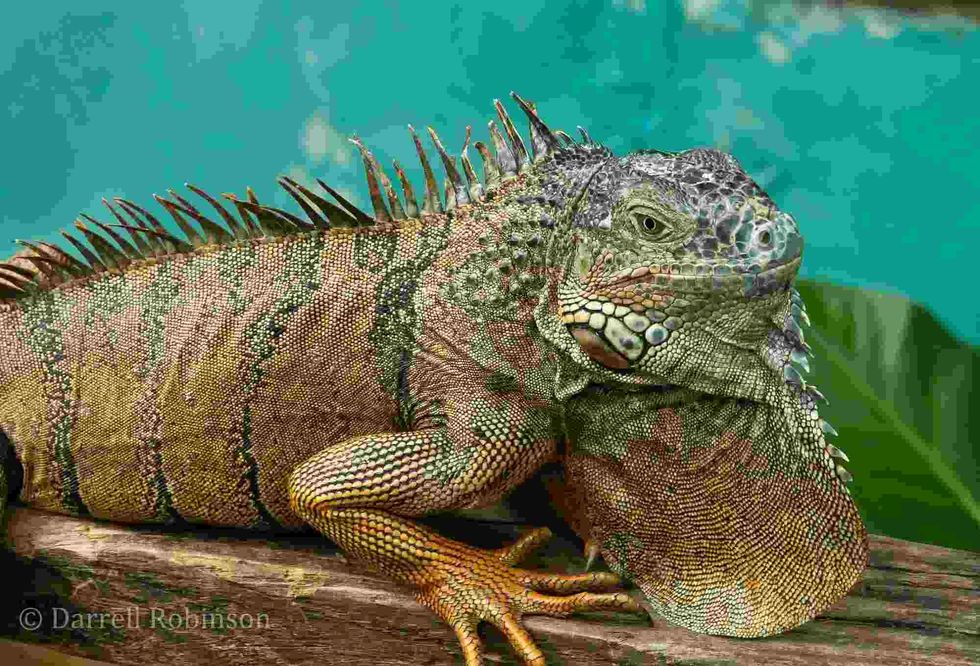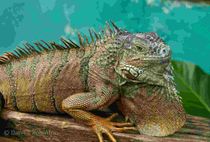There are a total of 35 species of iguanas in the world. Green iguanas belong to the same family. The scientific name for a green iguana is Iguana iguana. These reptiles are carnivorous beings and reside in tropical to subtropical regions.
Green iguanas range in native regions, including the Caribbean islands, Mexico, South America, and Central America. Green iguanas are herbivore beings and eat plants, fruits, and leaves. It is essential for them to stay close to forests and islands.
Male green iguanas are larger in size compared to females. Male green iguanas are also relatively more colorful compared to their female counterparts. This is primarily owing to sexual dimorphism. Male and female green iguanas are polyandrous and mate with multiple mates throughout their lifetime.
They lay between 10-30 eggs or more. Iguanas are one of the most popular pets adopted by people around the world. Iguanas and their eggs are also consumed by some people around the world.
For more relatable content, check out these marine iguana facts and iguana facts.
Green Iguana Interesting Facts
What type of animal is a green iguana?
The green iguana is a type of iguana that belongs to the kingdom Animalia, order Squamata.
What class of animal does a green iguana belong to?
The green iguana is a type of Iguana that belongs to class Reptilia, family Iguanidae and genus Iguana.
How many green iguanas are there in the world?
The green iguana population is estimated to be around 4 million in Puerto Rico by the Puerto Rican government. They are classified as a non-native species in that region. Total iguana populations have been estimated from 200,000-300,000, combining all geographic ranges. Green iguanas are classified as a Least Concern species by the IUCN.
Where does a green iguana live?
A green iguana lives in a geographic range of tropical rainforest and islands in canopies and trees. They are seen in countries including the Caribbean islands, Mexico, South America, and Central America. They inhabit a geographic range that suits their needs and are a non-native species.
What is a green iguana's habitat?
A green iguana's geographic habitat consists of canopies. They prefer regions with ample trees to seek shelter after basking in the sun. They have the capability to swim and the ability to live on land.
This helps them to escape predators. This species is most active during the day. They lay their eggs in underground holes or burrows to protect them from predators.
Who do green iguanas live with?
Green iguanas are solitary beings, but they do come together for mating. Juvenile iguanas are known to stay together in groups. They coexist with other wild species in forests or islands and are also seen owned by human's as pets.
How long does a green iguana live?
Iguanas may live up to 20 years when held in captivity and about eight years in the wild i.e., outside captivity. The oldest iguana recorded ever was a rhinoceros iguana which lived lived 40 years. The rhinoceros iguana belonged to the well-known Irwin's family. They need a humid temperature to regulate their body temperature and survive.
How do they reproduce?
Green iguanas reach sexual maturity at the age of four to five years. The breeding season usually occurs in the dry season. Males may mate with multiple females.
These iguanas have various courtship rituals after which this species mates. Females lay about 10-30 eggs per clutch, and incubation may last 90-120 days. The eggs are laid more than a meter below the ground.
What is their conservation status?
Green iguanas are classified as a Least Concern species by the International Union For Conservation Of Nature IUCN Red List of Threatened species.
Green Iguana Fun Facts
What do green iguanas look like?
Green iguanas look to have an overall green appearance but may also vary in color up to pale blue-gray. Apart from their color, they also have distinguishable features. They have a pendulous dewlap under their throat.
Their dorsal crest consists of spines right from mid-neck to their end. This is followed by a long tail. They have unwebbed feet with sharp claws.
Their face is similar to other lizards. Green iguanas have sharp teeth and a big mouth which they can easily use to swallow food.
An interesting feature of their appearance on their face is their eyes. They have two eyes situated laterally protected by eyelids, and apart from this, in the midline of their skull, they have a parietal eye which serves as a sensor for predators as well as a meter for solar energy. So technically, this species has three eyes.

How cute are they?
Yes, they are a unique and cute species of reptiles. However, this is a subjective opinion. These animals are the most accommodative of reptiles and amphibians. These exotic beings don't survive long in the wild.
How do they communicate?
Green iguanas communicate primarily via body signals or visual signals using their head and neck. Males also communicate via scent, where they mark their spots on trees and branches. They are also known to hiss in certain instances.
How big is a green iguana?
The green iguana is 11.8-16.5 in (30-42 cm) in body length which is bigger than the smallest lizard in the world, the nano chameleon which is 0.5 in (1.3 cm) in length.
How fast can a green iguana move?
Iguanas can travel at 21 mph (33.8 kph). Green iguanas can travel at fast speeds too. They stay within their habitat but can run fast if they sense a predator. They are excellent swimmers and can travel via the water too.
How much does a green iguana weigh?
A male green iguana weighs 8.8 lb (4 kg), and females weigh 2.6-6.6 lb (1.2 -3 kg). Blue iguanas are the heaviest iguanas and can weigh up to 30.8 lb (14 kg).
What are the male and female names of the species?
Males and female iguanas are not called differently. These animals differ in coloration and pattern as well as reproductive functions. This reptile is addressed or called by its name, green iguana.
What would you call a baby green iguana?
Once baby green iguanas hatch from their eggs, they are called hatchlings. The young are comparatively smaller in size and have a short tail, and travel in groups until they are big enough to live independently. Young iguanas are mostly spotted on the ground, rather than a tree.
What do they eat?
The green iguana diet is herbivorous. They consume their food using their sharp teeth, so their diet is largely green. They consume leaves, fruits, other plants, and leafy substances. They usually bring food closer to their mouth using their tongue and then swallow their food mostly without chewing. In the wild, they can also be spotted in a tree.
Are they poisonous?
No, these iguanas are not poisonous. Iguanas are known to possess venom glands, but this venom is harmless.
They are not dangerous or aggressive, however, if they do bite in extreme scenarios, it will need to be treated. In the wild, it's best to maintain a safe distance from such species. Those held in captivity are relatively more accommodative towards social interactions.
They are known to use their tail while they attack predators as well as their teeth. These lizards have predators including an owl, cottonmouth snake, coopers hawk, and cats as well as humans.
Would they make a good pet?
Green iguanas are the most popular pets kept in the family. These reptile pets require a high amount of care and attention.
They can grow to large lengths with time and can incur additional costs as they grow. These pets require an enclosure of a minimum of 12 ft (3.7 m) long, 6 ft (1.8 m) wide, and 8 ft (2.4 m) tall. Installing décor similar to real trees and branches would make this environment look more realistic.
They can't be kept in extreme climates and need to be kept in a tropical climate. They need access to drinking water at all times. Feeding them at regular intervals is essential, so its best consult a professional when considering adopting them. They may transmit various diseases including Salmonella, and need to be treated.
Humans may acquire these diseases from iguanas. Their price varies from $19.99-$599. The costs are region-specific.
Did you know...
Green iguanas can survive a fall of up to 40-50 ft (12.2-15.2 m). This is rarely seen in other animals.
The iguana, similar to various lizards, can break off their tail when grabbed or when it's in a position of threat. They are capable of growing a new tail over time.
The third eye in their life is a source for them to absorb vitamin D, enabling them to absorb UV light and strengthen their bodies. It is essential to install specific UV light sources when they are kept as pets.
Why are green iguanas bad?
Green iguanas are bad lizards primarily because of the damage they cause. They cause a lot of damage as a pet and are a difficult pet to own for first-time owners.
This lizard also requires constant care and attention. They are known to leave droppings everywhere, even if kept in enclosures. They may also cause damage to the tree décor or other similar installations if placed in their enclosure.
How to care for green iguanas?
Their price varies from $19.99-$599 and the costs are region-specific. Keeping this exotic lizard animal is not illegal and they can be taken care of if enough care and attention is provided.
They can't be kept in extreme climates and need to be kept in a tropical climate. They need access to drinking water at all times.
Feeding them at regular intervals is essential, so it's best to consult a professional when considering adopting them to see if they suit you best as a pet. If you cant keep one as a pet, you can observe them in their natural habitat in their geographic range.
Here at Kidadl, we have carefully created lots of interesting family-friendly animal facts for everyone to discover! For more relatable content, check out these sand lizard facts and gila monster facts for kids.
You can even occupy yourself at home by coloring in one of our free printable lizard mask coloring pages.









